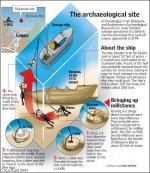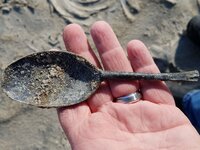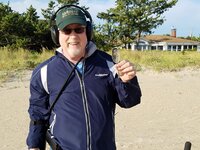Gypsy Heart
Gold Member
Long before beachcombers discovered thousands of fragments of broken pottery, glass and a few tiny toy soldiers on the beach near Roosevelt Inlet, the good citizens of Colonial Lewes likely salvaged wood, anchors and other items from a shipwreck just offshore.
What was left slipped below the surface, and from people's memories, until the fall of 2004, when a dredge used to pump sand onto the shoreline hit a corner of the shipwreck. It started spewing bits of German-made mineral water bottles, fragments of Dutch clay pipes and shards of British stoneware onto the beach in a slurry of sand and water.
State archaeologists have worked to find out more about this Colonial-era shipwreck -- the earliest of its kind known to be in Delaware waters -- and last week, a team of diver-archaeologists completed its field work at the wreck site about a quarter-mile off the beach.
"We found some things we didn't expect," said Daniel R. Griffith, project director with the Lewes Maritime Archaeology Project.
Among them, Griffith said, is the sense that the ship was probably heavily salvaged right after it went down.
What divers did not find -- big sections of wooden hull and anchors that would be expected on a ship --- tell state officials almost as much as what they did find.
They also discovered that a long wooden beam -- initially thought to be the keel -- was actually a deck clamp.
Divers did not find a keel, and that leads them to believe the ship ran aground and then keeled over on its starboard side in about 12 feet of water, said Michael Krivor, the project manager for Southeastern Archaeological Research Inc., of Jonesville, Fla.
"Ten feet of it would have been sticking" out of the water -- perfect for locals who were looking for everything from firewood to timber for construction, Griffith said.
The dive team also found what appeared to be a gun port that had been covered with lead sheathing, Griffith said. The ship had several lead sheathing patches, Griffith said. The covered gun port may be a clue that it was once a British naval vessel, he said.
Believed to be Severn
State officials believe the ship is the wreck of the Severn, which went down off Lewes on May 11, 1774.
A researcher in England has been combing British merchant ship records for clues under a contract with the state. She also found there was an HMS Severn that was used as a British naval ship in 1747. It was sold out of service in 1759, Griffith said.
The two Severns could be the same ship, he said.
"We will turn our researcher loose in England," he said.
Divers found few intact pieces that would match the artifacts found on the beach, Griffith said.
Researchers believe that may reflect the way the cargo was loaded onto the ship.
For instance, several large millstones have been found, and a few have been brought to the surface for additional study.
In addition, divers found hundreds of brass straight pins, hundreds of seed beads and 1,713 tobacco pipes and stems.
They also found a button dated 1772.
Peek into history
State officials are especially interested in the cargo because they believe it tells a story about the lock Britain held on trade with its colonies.
Although there were goods from many countries, all of the items had to pass through ports in Britain first.
The ship can tell researchers a great deal about what Colonial life and trade were like in the time leading up to the Boston Tea Party and the Revolutionary War, said Chuck Fithan, a state archaeologist.
Griffith said how the ship was salvaged and by whom is yet another area where more research is needed.
The latest work will include an analysis of the artifacts, including stabilizing them, and a full report from the state's archaeological consultants. The $300,000 work is being paid for with a state grant.
For Krivor, the project has been a great opportunity.
"It was one of those jobs that comes along very infrequently," he said.
While dive conditions were rugged because of poor visibility in Delaware Bay, Krivor said the opportunity to work on an 18th century shipwreck was amazing.
"The sheer amount of artifacts and the variety of artifacts" made it especially rewarding, he said.
Krivor said his favorite discovery was an intact brass iron. The only thing missing, he said, was the wooden handle.
The thing that made the iron so special was that two little dolphins would have held the wooden handle in place.
"Every dive," he said "was something new."
http://www.delawareonline.com/apps/pbcs.dll/article?AID=/20061107/NEWS/611070356/-1/NEWS01
What was left slipped below the surface, and from people's memories, until the fall of 2004, when a dredge used to pump sand onto the shoreline hit a corner of the shipwreck. It started spewing bits of German-made mineral water bottles, fragments of Dutch clay pipes and shards of British stoneware onto the beach in a slurry of sand and water.
State archaeologists have worked to find out more about this Colonial-era shipwreck -- the earliest of its kind known to be in Delaware waters -- and last week, a team of diver-archaeologists completed its field work at the wreck site about a quarter-mile off the beach.
"We found some things we didn't expect," said Daniel R. Griffith, project director with the Lewes Maritime Archaeology Project.
Among them, Griffith said, is the sense that the ship was probably heavily salvaged right after it went down.
What divers did not find -- big sections of wooden hull and anchors that would be expected on a ship --- tell state officials almost as much as what they did find.
They also discovered that a long wooden beam -- initially thought to be the keel -- was actually a deck clamp.
Divers did not find a keel, and that leads them to believe the ship ran aground and then keeled over on its starboard side in about 12 feet of water, said Michael Krivor, the project manager for Southeastern Archaeological Research Inc., of Jonesville, Fla.
"Ten feet of it would have been sticking" out of the water -- perfect for locals who were looking for everything from firewood to timber for construction, Griffith said.
The dive team also found what appeared to be a gun port that had been covered with lead sheathing, Griffith said. The ship had several lead sheathing patches, Griffith said. The covered gun port may be a clue that it was once a British naval vessel, he said.
Believed to be Severn
State officials believe the ship is the wreck of the Severn, which went down off Lewes on May 11, 1774.
A researcher in England has been combing British merchant ship records for clues under a contract with the state. She also found there was an HMS Severn that was used as a British naval ship in 1747. It was sold out of service in 1759, Griffith said.
The two Severns could be the same ship, he said.
"We will turn our researcher loose in England," he said.
Divers found few intact pieces that would match the artifacts found on the beach, Griffith said.
Researchers believe that may reflect the way the cargo was loaded onto the ship.
For instance, several large millstones have been found, and a few have been brought to the surface for additional study.
In addition, divers found hundreds of brass straight pins, hundreds of seed beads and 1,713 tobacco pipes and stems.
They also found a button dated 1772.
Peek into history
State officials are especially interested in the cargo because they believe it tells a story about the lock Britain held on trade with its colonies.
Although there were goods from many countries, all of the items had to pass through ports in Britain first.
The ship can tell researchers a great deal about what Colonial life and trade were like in the time leading up to the Boston Tea Party and the Revolutionary War, said Chuck Fithan, a state archaeologist.
Griffith said how the ship was salvaged and by whom is yet another area where more research is needed.
The latest work will include an analysis of the artifacts, including stabilizing them, and a full report from the state's archaeological consultants. The $300,000 work is being paid for with a state grant.
For Krivor, the project has been a great opportunity.
"It was one of those jobs that comes along very infrequently," he said.
While dive conditions were rugged because of poor visibility in Delaware Bay, Krivor said the opportunity to work on an 18th century shipwreck was amazing.
"The sheer amount of artifacts and the variety of artifacts" made it especially rewarding, he said.
Krivor said his favorite discovery was an intact brass iron. The only thing missing, he said, was the wooden handle.
The thing that made the iron so special was that two little dolphins would have held the wooden handle in place.
"Every dive," he said "was something new."
http://www.delawareonline.com/apps/pbcs.dll/article?AID=/20061107/NEWS/611070356/-1/NEWS01







